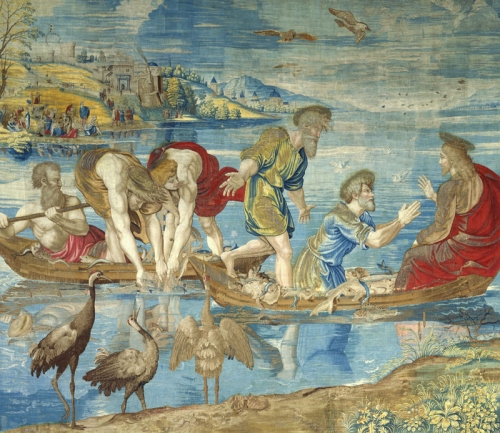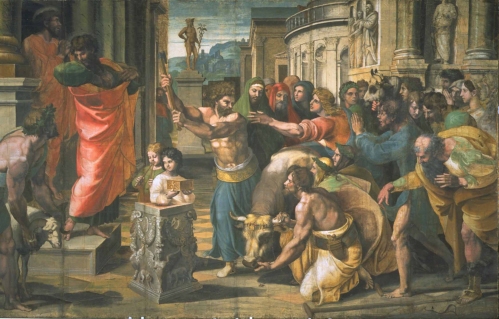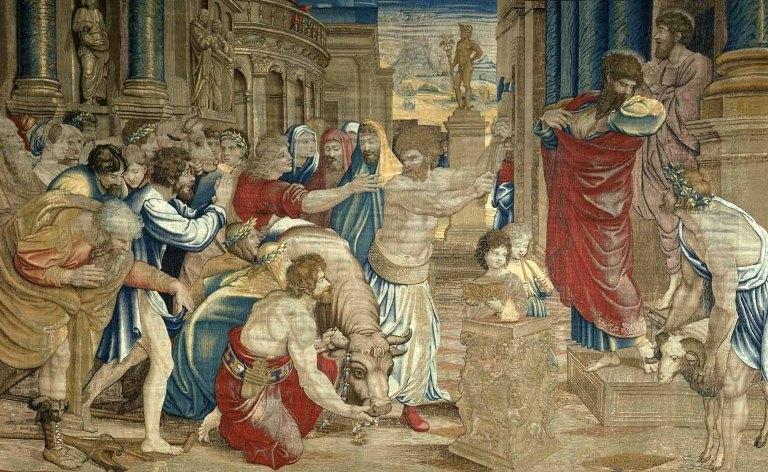To mark Pope Benedict’s controversial visit to Britain next week, the V&A have mounted an exhibition devoted to four of the 10 tapestries Raphael designed for the Sistine Chapel – the first time they’ve ever been seen in this country. Depicting the Acts of St Peter and St Paul, these bright, vivid works were made to hang on the lower walls of the Vatican’s principal chapel, below the older Michelangelo’s ceiling fresco
But even Raphael never saw the tapestries and his full-scale designs for them together: until now, they have never occupied the same space. Commissioned by Pope Leo X in 1515 (an impressive, highly realistic terracotta portrait bust of the Pope glowers grimly at us here), the full-scale, painted cartoons were sent to Brussels, Europe's leading centre for tapestry weaving, where they remained until purchased by the Royal Collection in this country by the future Charles I in 1623. They were placed on permanent loan to the V&A in 1865. To have the opportunity of comparing them, and to see how brilliantly the dramatic narratives of Raphael’s cartoons have been realised as tapestries - an art form that has been largely neglected for centuries - is an exciting prospect.

The Miraculous Draught of Fishes (pictured above) begins the cycle. It shows Peter kneeling before Christ, having just cast his net to produce a prodigious catch of fish. He is telling his master that he is unworthy of this miracle. The subtle tones used by Raphael in the cartoon have become much more vivid in the tapestry, although the colours are largely faithful. The elaborate vegetation in the foreground emphasises the weaver’s skill in this genre. Though worn and faded by time, the colours still sparkle with life – there is so much metal thread expended in the execution of these rich and lustrous works that they seem to throw out a luminous glow. The coiling columns of The Healing of the Lame Man, for instance, look like they’ve been dusted with a powdery silver coating.
With each scene busy with wildly jostling crowds and each individual figure beautifully modelled, the detailing in these tapestries is wonderful to examine at close hand. The Sacrifice at Lystra (tapestry, main picture above; cartoon, pictured below) shows such a bristling crowd scene.

Paul and Barnabas heal a lame man in the city of Lystra, and the people mistake them for the gods Jupiter and Mercury. Upon being offered a pagan sacrifice, Paul rips his garments in fury, while Barnabas pleads with the crowd to stop the sacrifice. Meanwhile, the healed man strides past his discarded crutches, his hands clutched in prayer, while another man stoops to examine more closely the miraculously restored leg.
As impressive achievements of the High Renaissance, these dazzling tapestries contain an expressive energy that is equal to many of the great paintings of the period. To see them in London for the first and, undoubtedly, the last time in a lifetime, is an unmissable opportunity.









![SEX MONEY RACE RELIGION [2016] by Gilbert and George. Installation shot of Gilbert & George 21ST CENTURY PICTURES Hayward Gallery](/sites/default/files/styles/thumbnail_125_x_125_/public/mastimages/Gilbert%20%26%20George_%2021ST%20CENTURY%20PICTURES.%20SEX%20MONEY%20RACE%20RELIGION%20%5B2016%5D.%20Photo_%20Mark%20Blower.%20Courtesy%20of%20the%20Gilbert%20%26%20George%20and%20the%20Hayward%20Gallery._0.jpg?itok=3oW-Y84i)





Add comment